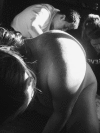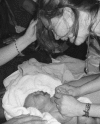Waiting to inhale: how to unhurry the moment of birth
- PMID: 22211055
- PMCID: PMC3209737
- DOI: 10.1891/1058-1243.20.1.8
Waiting to inhale: how to unhurry the moment of birth
Abstract
A doula and expectant mother's view of birth is forever changed when she sees a midwife simply place a newly born child below her mother at the moment of birth. The pause that the mother experiences in this moment as she studies, touches, and claims her child prompts the author to reflect in this guest editorial on ways we might be disturbing the natural sequence of birth as we deliver babies directly to their mothers' chests.
Keywords: birth satisfaction; doulas; midwifery care; natural birth; normal birth.
Figures
Similar articles
-
Impact of doulas on healthy birth outcomes.J Perinat Educ. 2013 Winter;22(1):49-58. doi: 10.1891/1058-1243.22.1.49. J Perinat Educ. 2013. PMID: 24381478 Free PMC article.
-
A birth intervention: the therapeutic effects of Doula support versus Lamaze preparation on first-time mothers' working models of caregiving.Altern Ther Health Med. 1998 Jul;4(4):73-81. Altern Ther Health Med. 1998. PMID: 9656503 Review.
-
Standard term of pregnancy.Midwifery Today Int Midwife. 2004 Winter;(72):51-3. Midwifery Today Int Midwife. 2004. PMID: 15651459
-
A qualitative study of volunteer doulas working alongside midwives at births in England: Mothers' and doulas' experiences.Midwifery. 2018 Jan;56:53-60. doi: 10.1016/j.midw.2017.10.002. Epub 2017 Oct 6. Midwifery. 2018. PMID: 29078074
-
Routine examination of the newborn: the EMREN study. Evaluation of an extension of the midwife role including a randomised controlled trial of appropriately trained midwives and paediatric senior house officers.Health Technol Assess. 2004 Apr;8(14):iii-iv, ix-xi, 1-100. doi: 10.3310/hta8140. Health Technol Assess. 2004. PMID: 15038906 Review.
References
-
- Colson S. D., Meek J. H., & Hawdon J. M. (2008). Optimal positions for the release of primitive neonatal reflexes stimulating breastfeeding. Early Human Development, 84(7), 441–449 - PubMed
-
- Klaus M. H. (1998). Mother and infant: Early emotional ties. Pediatrics, 102(Suppl. 5), 1244–1246 Retrieved from http://pediatrics.aappublications.org/cgi/content/full/102/5/SE1/1244 - PubMed
-
- Klaus M. H., Kennell J. H., Plumb N., & Zuehike S. (1970). Human maternal behavior at the first contact with her young. Pediatrics, 46(2), 187–192 Retrieved from http://pediatrics.aappublications.org/cgi/content/abstract/46/2/187 - PubMed
-
- Mercer J. S. (2001). Current best evidence: A review of the literature on umbilical cord clamping. Journal of Midwifery & Women’s Health, 46(6), 402–414 Retrieved from http://www.cordclamping.info/publications/LIT%20REVIEW%20ARTICLE-MERCER.pdf - PubMed
-
- Mercer J. S., & Skovgaard R. L. (2002). Neonatal transitional physiology: A new paradigm. The Journal of Perinatal & Neonatal Nursing, 15(4), 56–75 Retrieved from http://www.cordclamping.info/publications/Theory%20NNT%2002.pdf - PubMed
LinkOut - more resources
Full Text Sources



